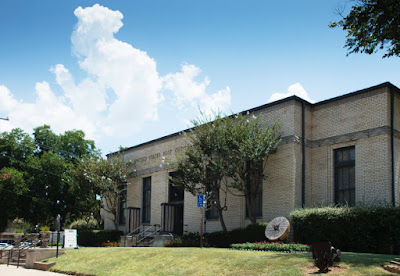Quanah is located at the south eastern corner of the Texas Panhandle. It is a small town with a big history. We focus on its post office.
Standing before the building, I noted that the architecture is identical to
the post office in Electra.
The building appears cared after carefully; indeed, the reliefs depicting the various ways that the U.S. Mail delivers -- by train, plane, and boat -- had several coats of paint to protect them. The lamps that flank the top of the stairs had no wear, considering their age. The mural looked good, too, and brilliantly conceived by the artist. I leave you with photos and the text I found on the wall.
MURAL IN THE U. S. POST OFFICE QUANAH, TEXAS
A Treasury Department Art Project
Commissioned by the Section of Painting & Sulpture
Procurement Division, Treasury Department
Executed by Jerry Bywaters in 1938
DESCRIPTION OF MURAL DESIGN
Quanah, the county seat of Hardeman County, Texas, was named after Quanah Parker, famous Comanche Chief. The mural is dominated by a life-size figure of Quanah Parker who is represented pledging peace and friendship to a white man who symbolizes all the early cattlemen and settlers of this region.
In addition to the dominating central group the mural depicts historical events in the left half and shows the contemporary interests of the town and territory in the right half.
LEFT SIDE OF THE MURAL
The country where Quanah is now located was originally the range for millions of buffalo. Near the townsite are several hills named "Medicine Mounds" by the Indians. Near these mounds the Texas Rangers captured Cynthia Ann Parker, mother of Quanah Parker.
Among the first white men to enter the territory were cattlemen who either used this part of the Plains as range or drove their cattle along the Pease River to the Kansas markets. The cattlemen gradually displaced the Indians and when the buffalo were killed of the Comanches were forced to move to the North of the Red River.
Although the country was opened up by the buffalo hunters and cattlemen, it was not really settled until after the coming of the railroads. The town Quanah was named by General G. M. Dodge who surveyed the first railroad through the country in 1885. The first passenger train came to Quanah over the Fort Worth and Denver railway in March, 1887.
RIGHT SIDE OF THE MURAL
After the coming of the railroads Quanah developed rapidly. Cattlemen replaced the longhorn with better beef stock. Cotton, wheat, and corn were cultivated extensively.
The industrial interests of Quanah were represented in the mural by plaster mills, cotton gins, oil mills, compresses, and railway repair shops. In 1905, an irrigation and power project was conceived and later the Lake Pauline dam was built furnishing water for the hydroelectric power plant of the West Texas Utilities Company.
"THE NAMING OF QUANAH" Mural Painting by Jerry Bywaters
QUANAH, TEXAS POST OFFICE:
The mural painting over the Postmaster's door was executed by Jerry Bywaters of Dallas, Texas. Mr. Bywaters received his commission as a result of an Honorable Mention in a Section of Fine Arts Competition.
DESCRIPTION OF THE MURAL:
The town of Quanah, Texas, was named for a Comanche Chief, Quanah Parker. In the center of the painting Parker is shown pledging peace and friendship to a white man who symbolizes the early cattlemen and settlers of this part of the Texas Panhandle. in the left background are items of historical interest: The "Medicine Mounds," the mesas are near which Cynthia Ann Parker, mother of Quanah, was captures by the Texas Rangers; a longhorn cattleman, one of many who first opened up the country; one of the early railroad trains which actually settled the area; General G. M. Dodge who surveyed the Fort Worth and Denver Railroad through Hardeman County in 1885. On the right hand side are represented contemporary activities and buildings; beef stock which replaced the longhorns; cotton, wheat, corn, and hog raising: plaster mills, cotton gins, oil mills, and cotton warehouses; high tension towers representing the lake Pauline dam and hydroelectric plant.
NOTE ON THE ARTIST:
Jerry Bywaters was born in Paris, Texas, May 21, 1906. He studied at the Southern Methodist University, Dalls, the Art Students League in New York and in Europe and Mexico. He has won many awards and he has exhibited widely. He is represented in the permanent collections of the Dallas Museum of Fine Arts, the Texas State College for Women, Trinity University in Waxahachie, the Princeton Print Club, North State Teachers College, and others. He has executed murals for the Dallas City Hall, and the Paris, Texas, Public Library. Mr. Bywaters is also an art critic and editor and is assistant Professor of Art, Southern Methodist University, Dallas, Texas. His other work for the Section of Fine Arts includes murals for the Post Offices in Houston and Farmersville, Texas.
SECTION OF FINE ARTS:
The Aim of the Section of Fine Arts is to secure murals and sculpture of distinguished quality appropriate to the embellishment of Federal buildings. Approximately 1% of the total limit of cost of the buildings is reserved for this decoration. The Section holds open anonymous competitions, national, regional, state or local, to which all citizen artists of the United States are eligible. A different jury of painters or sculptors, unattached to the Section, judges each competition.
SECTION OF FINE ARTS PUBLIC BUILDINGS ADMINISTRATION FEDERAL WORKS AGENCY
Original boxes, walls, and floors.

















































